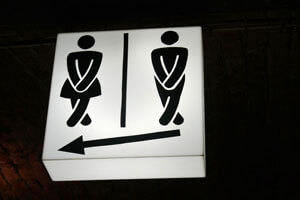Time to go
Do you spend an inordinate amount of time in the bathroom stall?
Voiding disorders affect urine storage and release because both are controlled by the same muscle mechanisms. Overactive bladder (OAB) and other voiding disorders can keep you from doing the things you love because you constantly live in fear of being too far away from a restroom. Using the restroom so frequently can also be embarrassing. In general, voiding disorders can affect your overall quality of life and lead to embarrassment.
What is overactive bladder?
Overactive bladder (OAB) is considered a voiding disorder and is characterized by the bladder squeezing urine out at the wrong time. One in six adults in the United States have symptoms of overactive bladder.
Symptoms of overactive bladder include:
- Sudden, strong urges to urinate immediately
- Leaking urine after a sudden, strong urge to urinate
OAB may be caused by contractions in the bladder that give you that sudden urge to use the restroom. Your everyday routine could be contributing to these spasms without you even knowing it. Foods that are known bladder irritants, medicines such as diuretics and urinary tract infections are all conditions that can affect your everyday voiding schedule.
OAB treatments
OAB is a treatable medical condition. Overactive bladder medications effectively treat the symptoms of OAB by helping to calm the bladder muscle and reduce the urge to void. In addition to medications, everyday choices and changes to your routine can help you manage your overactive bladder.
Everyday choices that can help you treat your OAB symptoms include:
- Watch your fluid intake. Drinking too much fluid can affect your bladder symptoms. If you are not drinking enough, constipation also can affect your OAB symptoms. Talk with your physician before you make any significant changes to your eating or drinking schedule.
- Work to strengthen your pelvic floor muscles. The pelvic floor is a series of muscles that help you to hold urine in your bladder. Over time, age and childbirth can weaken these muscles. Your pelvic floor muscles help stop the flow of urine. Work to squeeze and hold them and then release them for an equal amount of time.
- Make dietary changes. There are some foods that irritate your bladder and can exacerbate the symptoms of OAB. Caffeine, citrus fruits and juices, artificial sweeteners, tomato-based foods, sodas, alcohol, and spicy foods all have the ability to irritate your bladder and force you to visit the “stall world” more frequently.
Overactive bladder is a treatable medical condition that can be managed through medicine and lifestyle changes. You and your provider can discuss any more serious treatments if the lifestyle changes and medicines are not working for you.
